#sophont
Text
NEW ALIEN

I call them Ocira. They're a sort of combination of seals and octopus. They're eusocial and very kind
That wrinkly thing on their chest are their gills, which they can use to express certain emotions.
Their "teeth" are truly spines that can be raised to eat meat, or flattened to chomp plants.
To communicate, they do a sort of drumming and pinching of their swim bladders for different tones and squeaks.
They live on an ocean planet, in shallow, warm waters around reefs.
I might draw them more and tell more about them 😸
#art#digital art#orcatnip#xenobiology#spec bio#speculative biology#alien oc#meow#original creature#creature design#sophont
2K notes
·
View notes
Text

handses and feetses redesign
without text
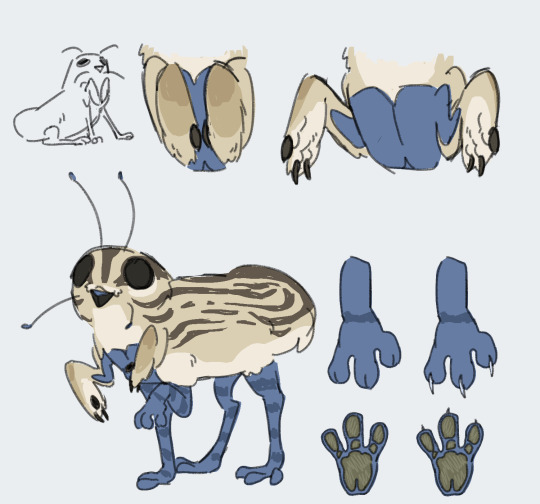
#ensthir#spec bio#spec evo#speculative biology#speculative evolution#speculative zoology#original species#alien species#sophont
1K notes
·
View notes
Text

Some basic anatomy notes on kee, one of the sophonts in Sea of Spires. They are the most common sophont in the Keeland biotope and, after the establishment of kee-gardens in the Terran biotope hundreds of years after first contact, are the most common Keeland sophont outside of their biotope.
Kee bodies are divided into six segments, each with a single limb and spiracle, arranged in an alternating pattern around their central nerve cord. This lends their bodies a slight asymmetry. Their first segment is most derived, with the limb adapted into a jaw and the spiracle adapted into a "vox" organ capable of synthesizing a wide range of sounds. In a typical kee the fore vox is only present on the right side and a second smaller vox sits on the left side of their terminal segment. In both the front limb and wing segments the spiracle remains intact as a breathing organ.
Also pictured is cranial differences between N and T-type kee, and genitalia differences between males and females. Both sexes have brightly colored flanges surrounding their cloaca for display, similar to the display flanges on their face. The main external difference is that males have brighter flanges and a pair of claspers flanking the cloaca.
N (nurturing) and T (territorial) type kee have no genital differences, but posess major morphological differences in the rest of the body. T-types have very brightly colored heads and wings, along with larger wing-claws and a more prominent beak spike. They are more aggressive and prone to wander, tending towards protecting the edges of a kee flock's territory and participating in foraging activities. N-types tend to fill more of a homemaker roll, raising and guarding young and maintaining their nests.
471 notes
·
View notes
Text

My half of an art trade with @honkowo!! Had a ton of fun drawing Clink, I love your angels so much :))
#spec bio#spec evo#speculative evolution#speculative biology#alien#creature#art trade#my art#sophont#angel
221 notes
·
View notes
Text

351 / GAZI-MIAH
At last this monster of a ref is finished. Introducing the first canon Knight character for Vivere 44!
351 is a mountain Knight from Ferhaht, though their host is part Fejga; hence the brown fur and stocky build. They act as the secondary antagonist in parts 1 and 2 of the story. In part 3, the final 'season', they feature as a protagonist. 351 starts out as a ruthless, aggressive soldier working for Genizix, intent on completing the mission assigned to them. Under the direction of their officer, 909, 351 has been dispatched to quickly and efficiently eliminate targets who threaten to expose the company's activities in the Zhagaviit galaxy.
Eventually they come to realise that they are being manipulated by both the weapons company and their abusive superior, and in part 2 351 challenges 909. Their fight results in 351 gaining an array of scars and a terrifying near-death experience, and though they survive, they are permanently mentally separated. Unable to go into the Trance which binds the consciousnesses of the Helmet and the Host, they must learn how to work together as two people again. 351 escapes to their homeplanet of Ettera, surviving in the wild as they race against time to deliver an important message and rediscover who they are. During part 3, they discard their identification number and take on a new name, Gazi-miah.
More in-depth lore, facts, and extra art below the cut!
BACKSTORY
[cw: abuse, drug use, general dark themes]
351 was always told that they were born in Genizix like 909, though this is not the case at all. 351 had a life before they were turned into a killing machine, living on the Ihmna Stretch with their Ferhahti order. Their life was upturned on the day of their scouting Expedition, a journey that all Knight squires must take on before they can become full soldiers (More on Knight social structure here). They were tasked to deliver a message to an allied order along with two other temporary scouts. Upon arrival, however, instead of friendly greetings they were met with a chilling scene - the order was being attacked by another, the two groups set against each other in a fearsome battle. The fight was secretly orchestrated by Genizix in a plot to evaluate the strongest soldiers to recruit to their cause, unbeknownst to anyone but them. Feeling that it was necessary to aid their allies, 351 and their peers rushed into battle. They fought fiercely, but the young Knights were up against fully-fledged soldiers and 351's companions perished. 351 themselves was severely injured, and in the aftermath, blacked out - but not before catching a glimpse of strange figures.
When they awoke, they were not on Ettera any more; rather an unfamiliar place with black walls and machines. They could barely remember anything from the night before; and slowly the rest of their memories on their homeplanet receded as Genizix toxins that they were injected with took effect. Later, 351 would be introduced to 909, an experienced Knight officer with an extensive history of working for Genizix, and placed in their unit. They were assigned a number for a name and moulded into the perfect killing machine. 909 fed 351 a constant stream of lies about where they came from, and like all soldiers recruited into the system, promised that in fighting for the company they had a chance to participate in something greater than themselves; to see the real universe outside of Zhagaviit. But 351 was driven more by fear than the potential for glory. They had seen what happened to those who disobeyed the higher-ups, and what could happen to them if they did not complete the missions.
909 stripped 351 of their individuality and left nothing but brute force and a desire to please. What the agent feared more even than Genizix was invoking 909's anger, so they pushed themselves to do any dirty work asked of them. The organisation became their whole world, their 'family', and 909 made sure they could never leave their clutches - manipulating them, threatening them and twisting their worldview. The process was sped up by specialised toxins designed by Genizix intended to distort perception and slow brain activity, inducing a dreamlike state. On Knights, this had the effect of triggering and enhancing the Trance, making it incredibly difficult for one to mentally separate the helmet from the host. With time 351 came to believe that they were one person, and they had no reason to think otherwise as their exposure to information was carefully controlled. 351 was conditioned to see their targets as non-sophont and they were rewarded for using cruel tactics. The more time they spent with 909, the more they began to lose their sense of self entirely until they were nothing but a weapon. Such is the fate of most soldiers who have wound up working for Genizix.
Despite the deep emotional (and physical) scarring and conditioning, during the events of Vivere 44 seeds of doubt are planted in 351's minds. These would only germinate further as they gain more clarity of their situation. Standing up to 909 was the first step they took towards breaking free of their chains, although it came with a cost. 351's host was physically Separated from their helmet in the fight, an injury which in most cases is lethal. They were repaired by a scientist who stitched them back together and managed to salvage a sliver of the bond which connected their minds. 351 could never enter the Trance again, though the helmet and host could still exchange thoughts between each other. As they were two separate entities now, the helmet guides the blind host with directions.
Instructed by the scientist (an Arrow named Nimbus, who will be introduced later) 351 left the facility on a new mission - to deliver an urgent message to Jes-ren, a Kaata Plains Knight living on a Ranch on Ettera. They traversed the land they once called home, now unfamiliar to them, relearning how to work together as a pair that might as well be complete strangers to each other. They recover their memories; or at the very least parts of it, as they cannot remember their original name. However, they gain a new one; Gazitkaar-Miahlad [meaning: lost messenger / returned to us].
The road is long and tremendously difficult; Gazi-miah struggles to unlearn years of aggression, addiction and lies, all the while carrying immense trauma. They eventually find peace, and settle down with Jes-ren in Kaat following the climax.
PERSONALITY
During their time at Genizix, agent 351 picked up on a lot of nasty habits and traits from 909 who brought out their worst attributes. They became merciless, taught to discard feelings and remorse. 351 was not afraid to make a show of their strength, and at times was needlessly cruel and taunting. The toxins affecting their nervous system tended to spur on their host's prey drive to a concerning degree, and a part of them enjoyed the power trip they got from hunting down targets. Though everything they did, they did for 909's approval - and to avoid getting disposed of by Genizix.
When their host and helmet were Separated, and the effects of the toxins wore off, gradually their aggressive attributes took a backseat as they grappled with their new situation. With great effort they gain an understanding of both the horrors they went through and the atrocities they committed for the sake of a corrupted system.
Once they escape Genizix's hold, it becomes clear that 351 is incredibly socially inept and any interaction that isn't violence or taking orders is new territory for them. Freedom and agency are difficult concepts for them to grasp, but with the aid of others around them they begin to adjust to their new life.
The helmet, Miahlad (my-a-lad) is the more practical of the two. He has one goal in mind; keeping the both of them safe. Miah is resourceful and smart, though when it comes to social interaction he's just as clueless as his host. This doesn't stop him from offering advice via their mind-link. He is firm, distrustful, and judgemental, but cares deeply for Gazitkaar even if he won't say it. At first he is reluctant to uncover the truth in fear that it will harm them both, preferring to stick to familiar ground. Despite his realistic worldview, more than once he considers going back to Genizix due to the simple fact that it's all they've ever known - even if it hurt them. As a helmet he cannot speak out loud but relearns sign language to communicate with other knights.
The host, Gazitkaar (gaz-it-car) is constantly questioning everything. She is less focused on the personal safety and wellbeing of the Knight body and more concerned with the wider truth, always seeking to know more. Gazi is not one to back down from a challenge, whether it be traversing dangerous territory or mastering a new skill. But like Miah, she is averse to touch, and will bite if boundaries are pushed far enough. She is more open to listening than her helmet, and is a fast learner. Though she is more adaptable than Miah, her curiosity can sometimes go unchecked and lead them into trouble.
EXTRAS
They are 37 years old and tower over everyone, including other Knights. Their prescence could fill a whole room.
The engraved bone necklace was given to them by a Polar Knight commander from Ehtte Thannoeh where they first landed on Ettera. The carving depicts an Aikka deity whose horn always points northwards, and is said to watch over lost travelers from the northern lights.
Gazi-miah's piercings were put in by the scientist Nimbus, intended to firmly fix the helmet to the host.
As a Genizix agent their build is very toned and muscular due to their intense training and strength-enhancing substances which also speed up wound recovery. Such a lifestyle was placing immense stress on their body, and as they spent more time on Ettera they gained more weight and adopted a healthier diet.
Their build and design is inspired by bulls and rottweilers.
Their fur is spiky due to chemicals and unnatural cleaning products resulting in an unpleasant, rough texture. In the future it becomes softer thanks to proper grooming.
Here's some of the first concept art I have of them (and also showcases their pelt colours better)
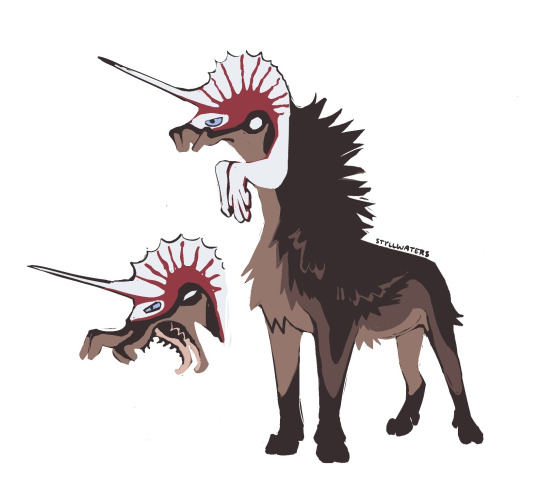

Aaand a simplified version of the ref without all the notes for your viewing pleasure.
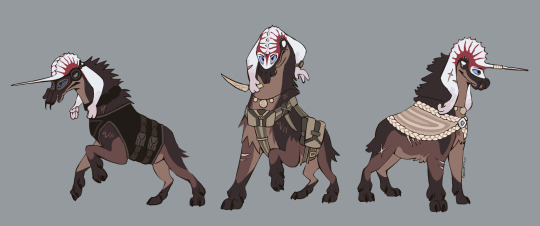
I'll stop here before this post gets insanely long but if you have any questions I shall be delighted to answer!! ;] Thanks for listening to my tedtalk
#a little later than anticipated but ITS HERE!!#my beloved#sorry for the infodump. can you tell ive been thinking about these guys a lot#vivere 44#my art#knights#sophont#oc#original character#speculative biology#spec bio#speculative evolution#art#reference sheet#long post#abuse mention#drug mention#alien#character design#put them through the horrors but what else is new
280 notes
·
View notes
Text

First named Salii'Qi character :) her name is Sillca and she lives and travels with her rancher girlfriend. Sillca is less hands on and makes and embroiders clothes with hides and fibers found in the desert plants.
Oh, you can also draw her for Artfight if you'd like <3 https://artfight.net/character/3465357.sillca-rasayae
#shes my daughter and i love her so#sillca ra'sayae#salii’qi#saliinthia#alien#spec evo#speculative evolution#speculative ecology#speculative biology#sophont#xenobiology
425 notes
·
View notes
Text
Updated 2-3 design and also more crescent art


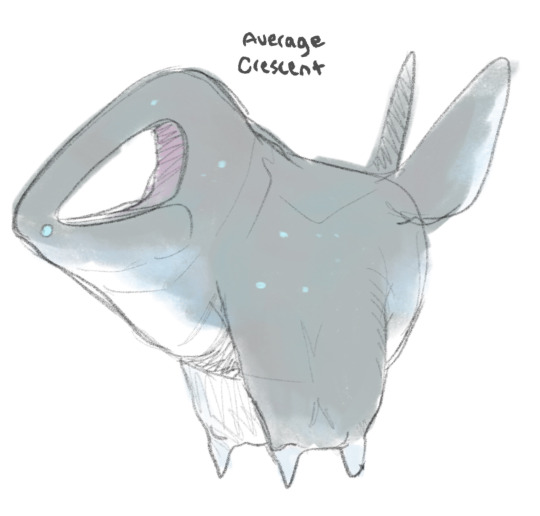
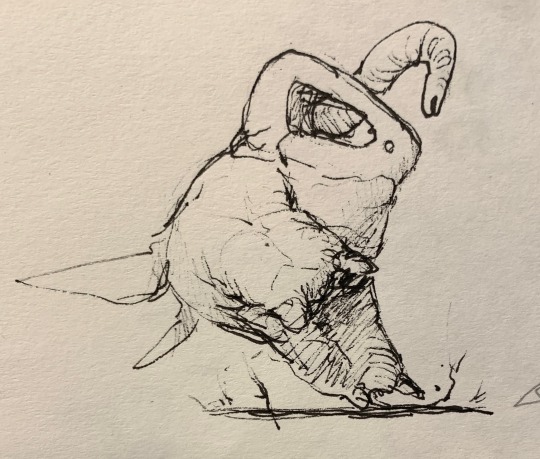
I am planning on revamping Crescents colors a bit, basically adding counter shading and meaning to the color.
Crescents sort of breathe through their skin a bit, in order to absorb ions from the atmosphere. Their skin color then reflects that ion intake and also their general race (which is usually dependent on their biome, like purple for forests). But 2-3 is weird, he grew up in a space station and was exposed to lots of radiation. So he is a weird green color. He also glows in the dark a little bit… hehe. It doesn’t hurt him at all ofc. Just like dying your hair. If 2-3 went to live on his moon for a few years, his skin would become slightly more muted.
The “average crescent” palette is what I just call “skin colored”. Crescents have blue blood, so any blue on the crescent is just parts of their blood spotting through. So it’s akin to normal humans being more reddish. The pink is a highly pigmented area, as most feelers and holes are. Some crescents holes become dull with age, so many like to use makeup to recolor it. Sometimes even crazy patterns!
#crescents#alien species#alien oc#species design#intelligent species#sophont#speculative biology#speculative evolution#xenobiology#alien#art#my art#character design#cathchicken
147 notes
·
View notes
Text

oh sorry, did you think that last post I made was a final design? I've been working on these assholes for over 2 years straight and there are versions of them that will never see the light of day; I'm not about to *stop* just because I posted one online 🙃
I spent a few hours writing up a lore dump for these guys before deciding it should wait until I have a lineup with more variants
#speculative biology#speculative evolution#creature design#sophont#fantasy race#kh project#kh ogodai#Ive written it it just has to go on the right post
139 notes
·
View notes
Text

Koolu explorer and their Drarg hound
123 notes
·
View notes
Text
The Astutocentaurini & Death Part 2: Utility Vessels
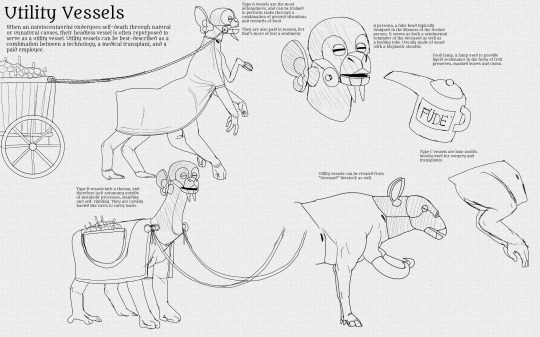
As discussed before, the Astutocentaurini believe in the idea of two deaths: death of the self (the head) and death of the vessel (the body). But how are headless citizens dealt with while still alive? Following self-death, the vessel of an Athyrmatherian has the potential to live for a long time under controlled conditions, anywhere from a year to nearly a century, depending on the creature's species and age. The feudal societies of the world have thus converged on a similar solution: At some point in their adult life, a person will usually be required to sign a will in which they can either decline or agree to posthumously donate their vessels to society. These repurposed vessels are known as "utility vessels."
A utility vessel can be considered an archaic sort of biotechnology, an organic automaton that can be sold and used for various purposes. When awaiting ownership or rental by an employer, they are typically housed and maintained in storage facilities called "body shops," eerily reminiscent of auto shops in their presentation and purpose. They can even be modified surgically and "mechanically" to certain degrees if permitted by a will, although more extensive cases of body modification can be rather controversial. Despite this apparent commoditization, utility vessels are treated with an odd yet palpable sense of respect and reverence, which is culturally analogous to our respect for the dead. Indeed, the very shops they are sold by tend to be subsidiaries of the same funeral homes that house their deceased selves, and employers are legally obligated to return dead vessels so they can be buried in the same graves. With each use, utility vessels are paid in money for their services, and some laws and regulations advise against any particular uses that may be deemed indignant to the former persons. It is also common for utility vessels to be dressed in lavish and beautiful garbs or intricately carved bioplastic shells that match their cultural backgrounds. The centerpiece of these decorations is a custom-carved "persona," a fake head that, in addition to functioning as a feeding tube, serves as a symbolic reminder of the person the vessel used to be attached to.

Under native legal definitions, utility vessels are usually classified into three types based on their composition and functionality. Type "A" utility vessels consist of the thoracic, upper, and lower abdominal zooids, with the thoracic zooid housing a ganglion that makes them autonomous enough to perform specific tasks in response to certain stimuli. This allows them to haul or carry loads similar to pack animals, with the behaviors being conditioned through rhythmic ground vibrations and rewards of liquid food. Type "B" utility vessels consist of only the upper and lower abdominal zooids, and they lack autonomy outside metabolic regulation and basic righting and balancing. Due to this, they have to be pulled or pushed manually like living carts, and they are mostly used to carry lighter loads or to act as portable bases for more stationary equipment. Type "C" utility vessels are essentially any singular zooid that is separated from a composite, and they are typically relegated to use as a surgery stock for organ transplants, zooid replacements, and sometimes to "construct" more complete utility vessels.
88 notes
·
View notes
Text

Jiralf* Infant Development
Very little is known of Jiralf culture and biology, and what we do know is only given to us by dissenters. Due to the war, information on anything jiralf related is very minimal, however, we do know some things.
Mostly that baby jiralves are able to walk before they are a year old. there are many theories as to why this is, but the main one is the fact that, while jiralves are the dominate species of their planet, they still are hunted by predatory animals.
And adult jiralf can only carry an infant for maybe the first five (5) months of the infants life, before they become too heavy for the jiralf's "arms". While a baby can be easily carried on the mother's or father's back, the ability to walk becomes an important part of an infants early development. Even if it's not as important as it use to be.
*yee-rahlf
#my art#salt and light#world building#worldbuilding#xenobiology#art#art room#fantasy#stardust nibiru#digital art#small artist#artist of tumblr#artists on tumblr#alien#original species#sophont
87 notes
·
View notes
Text

Four Kerilone outfits for various occasions. Dyes are not very common and quite hard to make, so most everyday clothes are undyed as in the winter outfit. However, red and blue dye - red from a plant, blue from various shellfish - are available. Kerilone courting takes place in the summer. The Kerilone are protandrous hermaphrodites, which means they all hatch male and gain the ability to become female upon reaching maturity. Females are larger than males, with darker colouring, and are less agile but stronger than males. Every year in winter the Kerilone shed their summer coats and grow new, white and fluffy winter coats (not shown in the picture), as well as losing their sexual characteristics as well as their ability to reproduce - the winters are very harsh, so all of their energy is needed simply to survive. After the winter, young adults can become either male or female: they have a modicum of choice in the matter, but it is largely down to environmental influences. However, as they age they lose the ability to become male and remain female for the rest of their lives. Like most Earth species they do not go through a menopause, however the average amount of chicks a Kerilone will rear in their lifetime is only about ten.
#sophont#creature design#speculative evolution#speculative biology#worldbuilding#spec evo#alien#keriworld#procreate#procreate art#artists on tumblr#alien oc#character design#original art#that was a long post! kerilone gender/sex is weird#thanks for reading
127 notes
·
View notes
Text

So... My first actual post on this account! This is Rilicai, a Kerilone (race of vaguely equine sophonts) that I've been designing recently. She lives on a swampy planet orbiting a M-Class star.
#speculative biology#speculative zoology#spec evo#speculative evolution#alien oc#alien species#sophont#procreate#original art#artists on tumblr#adding tags is so boring and my phone is about to die too#keriworld#my art
99 notes
·
View notes
Text

More info on basic kee anatomy. From the top, the slight asymmetry in their bodies is more apparent. This also illustrates the differences between N-type and T-type wings, with T-type wings being brightly pigmented and having more prominent claws. Here you can also see their smaller aft vox. Kee can produce sounds through both fore and aft voxes simultaneously and can create a wide range of sounds with each, though the aft vox is quieter and less resonant.

Here is a bit more information on their basic bauplan, which is shared by other members of their group of organisms. I refer to them as Streptisomazoans (twisted-body-animals), but this is not the term they are referred to with in-universe. Societies in Sea of Spires do have biological sciences and ideas of phylogenetic relationships, but they aren't identical to the way we talk about these concepts in western science.
83 notes
·
View notes
Text

woohoo whoopee ms paint potential feltaur redesign
#spore#spore 2008#<- they're technically a spore species hence these tags#speculative biology#speculative evolution#my art#doodles#spacecreate#feltaur#feltaurs#spec bio#spec evo#xenobiology#alien#sophont
177 notes
·
View notes
Photo

they sniff - they snorf - they’re Snorps!
Snorps are the second sophont species to evolve on the planet Ilvoa. The first - the Yilvots - were one of the original peoples to create the UAP. At the time, Snorps were intelligent animals on-par with 21st century Earth ravens, sometimes kept as pets. When the Yilvots as a whole began to move past physical possessions, they saw the opportunity to foster and encourage the Snorps’ intelligence, eventually leading to their “awakening” as intelligent people in their own right.
Snorps are about 2ft tall and come in (mostly) browns, blacks, and greys. Their fur is course along their backs, and softer and finer on their heads. They have short, fine fur on their tails, limbs, and trunk, with their feet and mouths hairless. Snorps have no eyes, but excellent senses of smell and good hearing. They have 3 fingers and a thumb on each hand, and 3 toes on each foot.
Yilvots introduced clothing to them, and Snorps learnt that bright colours make them more likely to be seen by larger peoples. For shopping they usually have a tool that tells them what colour something is, and most Snorps have preferences, mostly based on vibes. They like clothing with lots of pockets and usually carry a couple bags with them i’m terrible at clothes so i didn’t draw this shhh. They also love fun sounds and textures so will usually have some sensory toys on their person.
Pictured here are Nan and Sharlee - Nan is a xenobotanist, and Sharlee is a transcriptionist and an artist. They’re in their enemies-to-lovers era rn
#spec bio#speculative biology#speculative zoology#speculative evolution#spec evo#xenobiology#alien design#creature design#sophont#my art#snorps#CoS#Nan#Sharlee
166 notes
·
View notes